Business Management: Roles, Styles, Change, Communication in Business
VerifiedAdded on 2023/06/11
|9
|2728
|178
Essay
AI Summary
This essay provides a detailed analysis of business management, covering the roles of management at different levels (senior, middle, and lower), various management styles (democratic, transactional, bureaucratic, etc.), and the reasons for and approaches to managing change within a business. It also evaluates the importance of effective communication in decision-making and the nature and use of different management information systems. The report emphasizes how these elements contribute to organizational success, employee motivation, and overall performance improvement. The student assignment is available on Desklib, a platform offering study tools and resources for students.
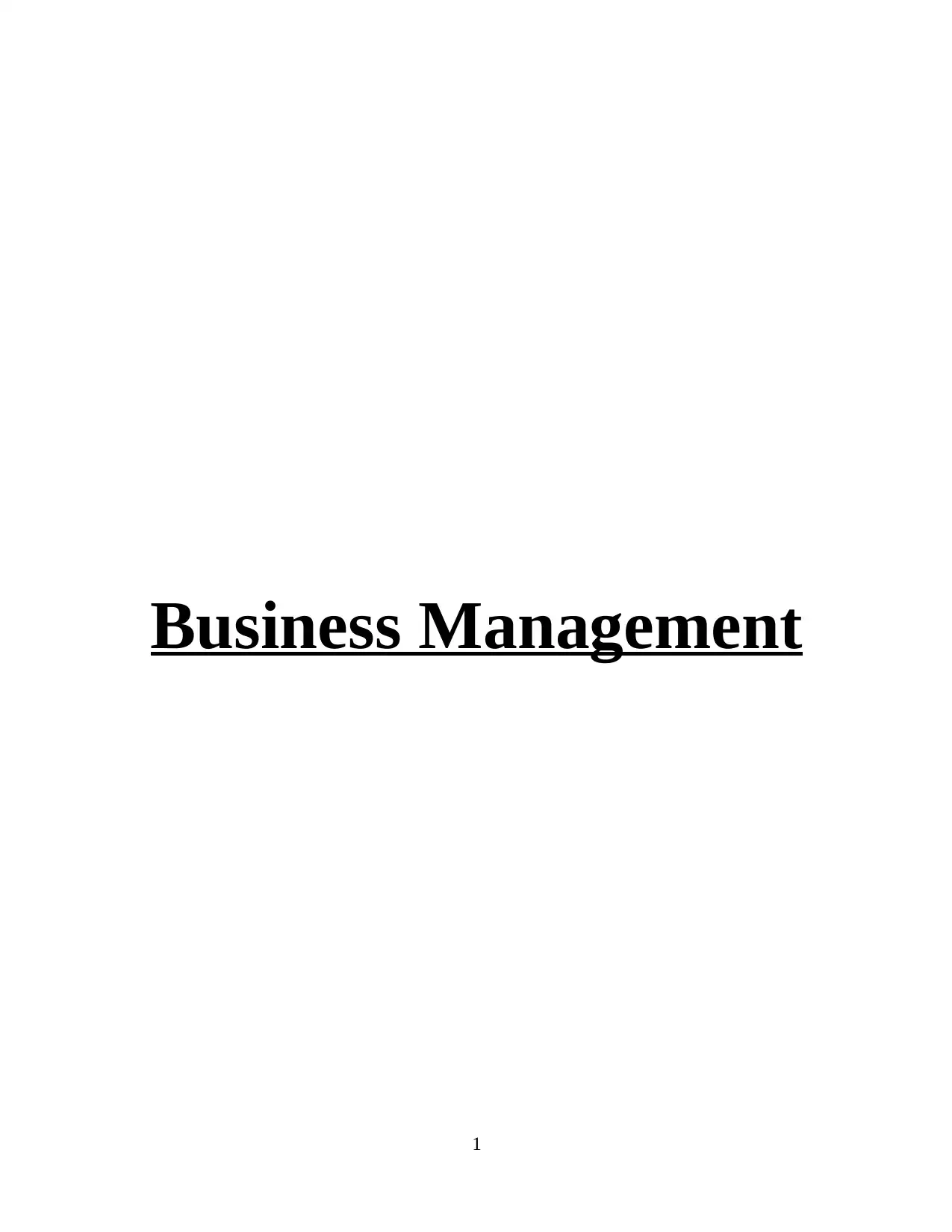
Business Management
1
1
Paraphrase This Document
Need a fresh take? Get an instant paraphrase of this document with our AI Paraphraser
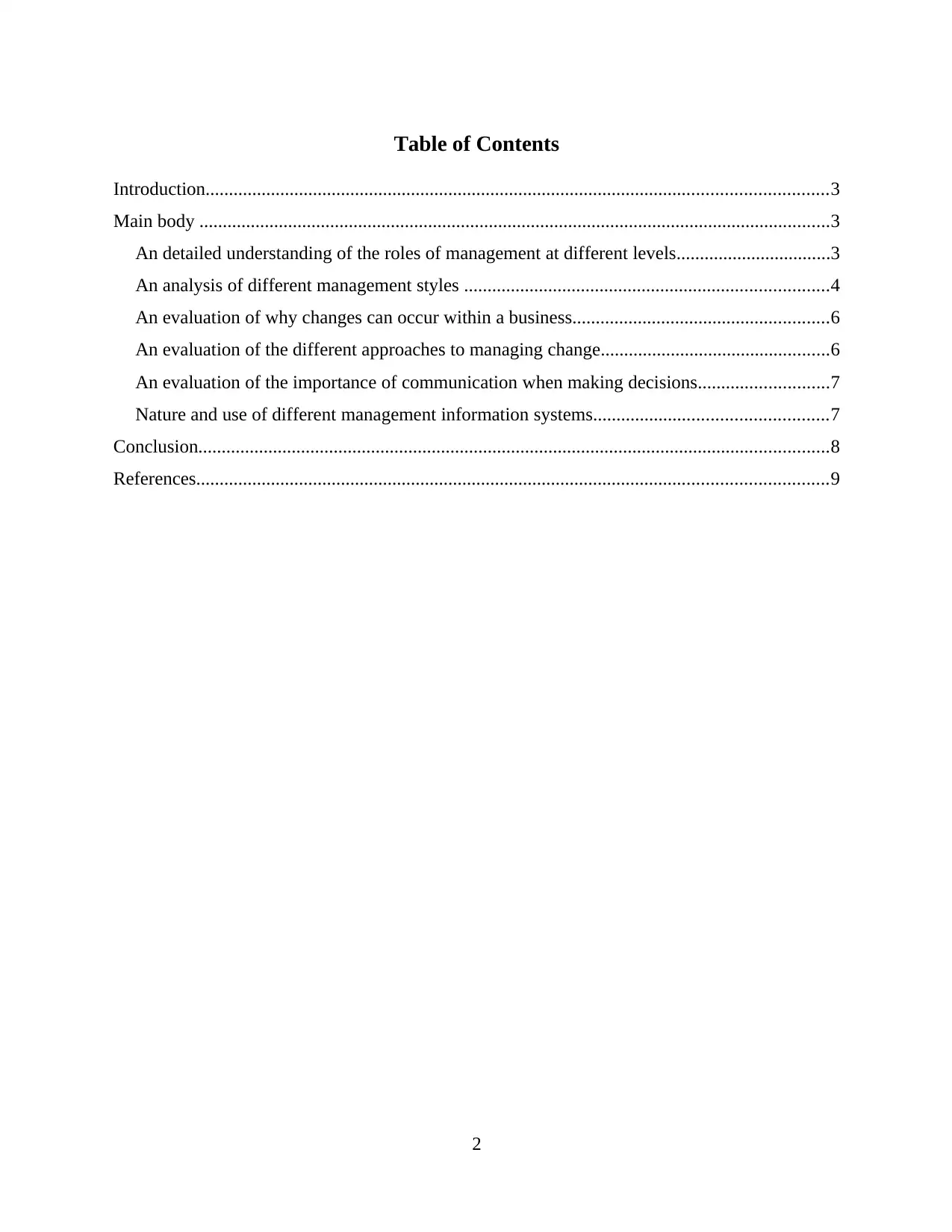
Table of Contents
Introduction.....................................................................................................................................3
Main body .......................................................................................................................................3
An detailed understanding of the roles of management at different levels.................................3
An analysis of different management styles ..............................................................................4
An evaluation of why changes can occur within a business.......................................................6
An evaluation of the different approaches to managing change.................................................6
An evaluation of the importance of communication when making decisions............................7
Nature and use of different management information systems..................................................7
Conclusion.......................................................................................................................................8
References.......................................................................................................................................9
2
Introduction.....................................................................................................................................3
Main body .......................................................................................................................................3
An detailed understanding of the roles of management at different levels.................................3
An analysis of different management styles ..............................................................................4
An evaluation of why changes can occur within a business.......................................................6
An evaluation of the different approaches to managing change.................................................6
An evaluation of the importance of communication when making decisions............................7
Nature and use of different management information systems..................................................7
Conclusion.......................................................................................................................................8
References.......................................................................................................................................9
2
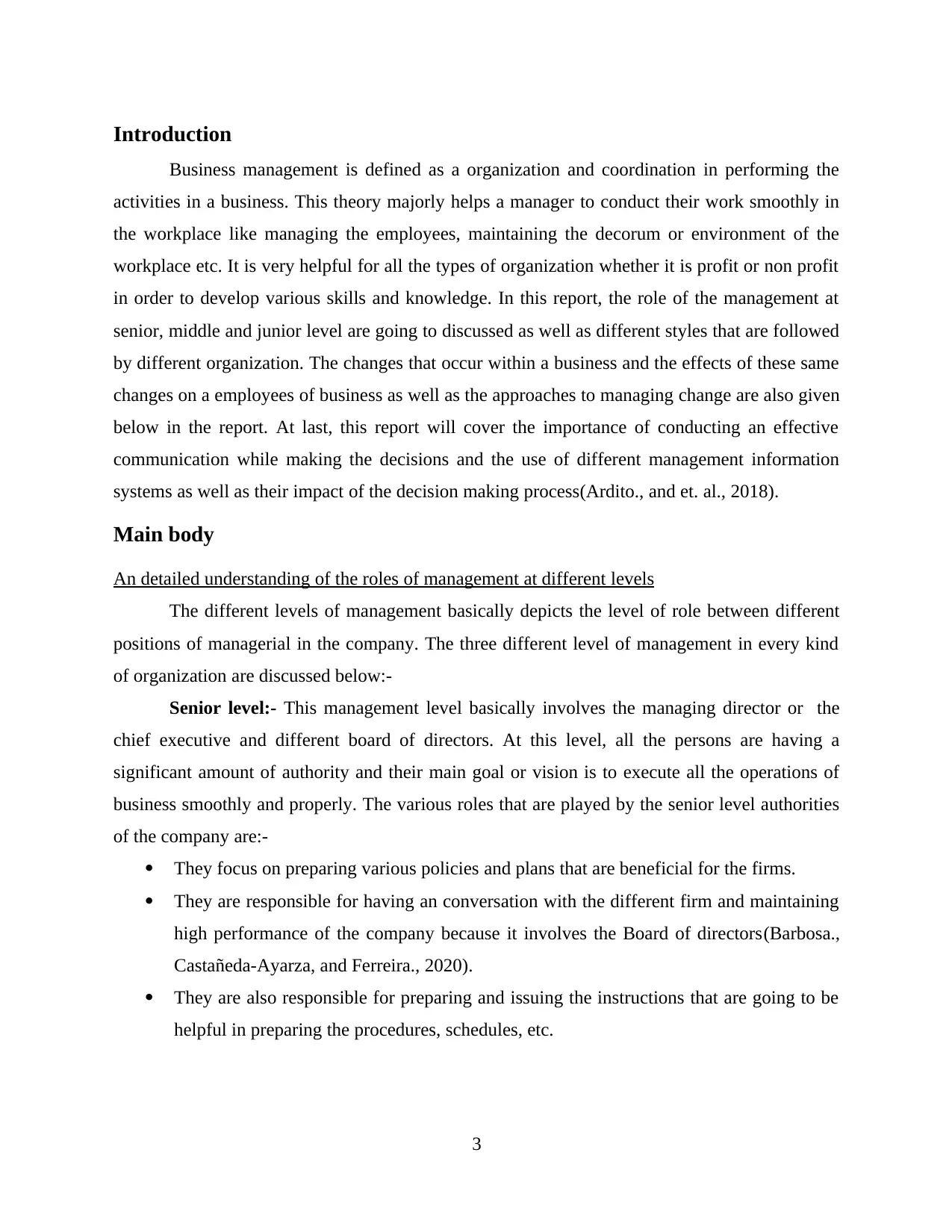
Introduction
Business management is defined as a organization and coordination in performing the
activities in a business. This theory majorly helps a manager to conduct their work smoothly in
the workplace like managing the employees, maintaining the decorum or environment of the
workplace etc. It is very helpful for all the types of organization whether it is profit or non profit
in order to develop various skills and knowledge. In this report, the role of the management at
senior, middle and junior level are going to discussed as well as different styles that are followed
by different organization. The changes that occur within a business and the effects of these same
changes on a employees of business as well as the approaches to managing change are also given
below in the report. At last, this report will cover the importance of conducting an effective
communication while making the decisions and the use of different management information
systems as well as their impact of the decision making process(Ardito., and et. al., 2018).
Main body
An detailed understanding of the roles of management at different levels
The different levels of management basically depicts the level of role between different
positions of managerial in the company. The three different level of management in every kind
of organization are discussed below:-
Senior level:- This management level basically involves the managing director or the
chief executive and different board of directors. At this level, all the persons are having a
significant amount of authority and their main goal or vision is to execute all the operations of
business smoothly and properly. The various roles that are played by the senior level authorities
of the company are:-
They focus on preparing various policies and plans that are beneficial for the firms.
They are responsible for having an conversation with the different firm and maintaining
high performance of the company because it involves the Board of directors(Barbosa.,
Castañeda-Ayarza, and Ferreira., 2020).
They are also responsible for preparing and issuing the instructions that are going to be
helpful in preparing the procedures, schedules, etc.
3
Business management is defined as a organization and coordination in performing the
activities in a business. This theory majorly helps a manager to conduct their work smoothly in
the workplace like managing the employees, maintaining the decorum or environment of the
workplace etc. It is very helpful for all the types of organization whether it is profit or non profit
in order to develop various skills and knowledge. In this report, the role of the management at
senior, middle and junior level are going to discussed as well as different styles that are followed
by different organization. The changes that occur within a business and the effects of these same
changes on a employees of business as well as the approaches to managing change are also given
below in the report. At last, this report will cover the importance of conducting an effective
communication while making the decisions and the use of different management information
systems as well as their impact of the decision making process(Ardito., and et. al., 2018).
Main body
An detailed understanding of the roles of management at different levels
The different levels of management basically depicts the level of role between different
positions of managerial in the company. The three different level of management in every kind
of organization are discussed below:-
Senior level:- This management level basically involves the managing director or the
chief executive and different board of directors. At this level, all the persons are having a
significant amount of authority and their main goal or vision is to execute all the operations of
business smoothly and properly. The various roles that are played by the senior level authorities
of the company are:-
They focus on preparing various policies and plans that are beneficial for the firms.
They are responsible for having an conversation with the different firm and maintaining
high performance of the company because it involves the Board of directors(Barbosa.,
Castañeda-Ayarza, and Ferreira., 2020).
They are also responsible for preparing and issuing the instructions that are going to be
helpful in preparing the procedures, schedules, etc.
3
⊘ This is a preview!⊘
Do you want full access?
Subscribe today to unlock all pages.

Trusted by 1+ million students worldwide
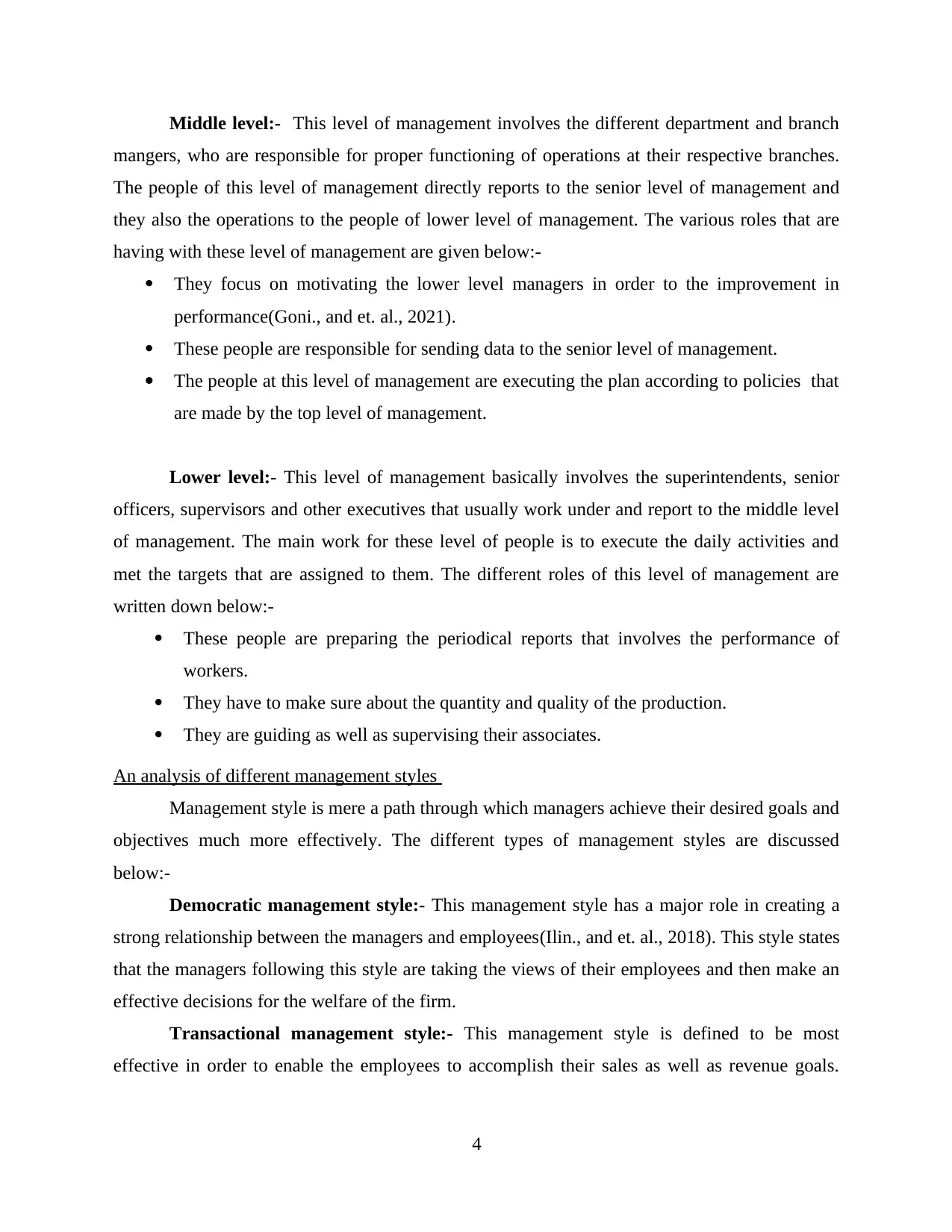
Middle level:- This level of management involves the different department and branch
mangers, who are responsible for proper functioning of operations at their respective branches.
The people of this level of management directly reports to the senior level of management and
they also the operations to the people of lower level of management. The various roles that are
having with these level of management are given below:-
They focus on motivating the lower level managers in order to the improvement in
performance(Goni., and et. al., 2021).
These people are responsible for sending data to the senior level of management.
The people at this level of management are executing the plan according to policies that
are made by the top level of management.
Lower level:- This level of management basically involves the superintendents, senior
officers, supervisors and other executives that usually work under and report to the middle level
of management. The main work for these level of people is to execute the daily activities and
met the targets that are assigned to them. The different roles of this level of management are
written down below:-
These people are preparing the periodical reports that involves the performance of
workers.
They have to make sure about the quantity and quality of the production.
They are guiding as well as supervising their associates.
An analysis of different management styles
Management style is mere a path through which managers achieve their desired goals and
objectives much more effectively. The different types of management styles are discussed
below:-
Democratic management style:- This management style has a major role in creating a
strong relationship between the managers and employees(Ilin., and et. al., 2018). This style states
that the managers following this style are taking the views of their employees and then make an
effective decisions for the welfare of the firm.
Transactional management style:- This management style is defined to be most
effective in order to enable the employees to accomplish their sales as well as revenue goals.
4
mangers, who are responsible for proper functioning of operations at their respective branches.
The people of this level of management directly reports to the senior level of management and
they also the operations to the people of lower level of management. The various roles that are
having with these level of management are given below:-
They focus on motivating the lower level managers in order to the improvement in
performance(Goni., and et. al., 2021).
These people are responsible for sending data to the senior level of management.
The people at this level of management are executing the plan according to policies that
are made by the top level of management.
Lower level:- This level of management basically involves the superintendents, senior
officers, supervisors and other executives that usually work under and report to the middle level
of management. The main work for these level of people is to execute the daily activities and
met the targets that are assigned to them. The different roles of this level of management are
written down below:-
These people are preparing the periodical reports that involves the performance of
workers.
They have to make sure about the quantity and quality of the production.
They are guiding as well as supervising their associates.
An analysis of different management styles
Management style is mere a path through which managers achieve their desired goals and
objectives much more effectively. The different types of management styles are discussed
below:-
Democratic management style:- This management style has a major role in creating a
strong relationship between the managers and employees(Ilin., and et. al., 2018). This style states
that the managers following this style are taking the views of their employees and then make an
effective decisions for the welfare of the firm.
Transactional management style:- This management style is defined to be most
effective in order to enable the employees to accomplish their sales as well as revenue goals.
4
Paraphrase This Document
Need a fresh take? Get an instant paraphrase of this document with our AI Paraphraser
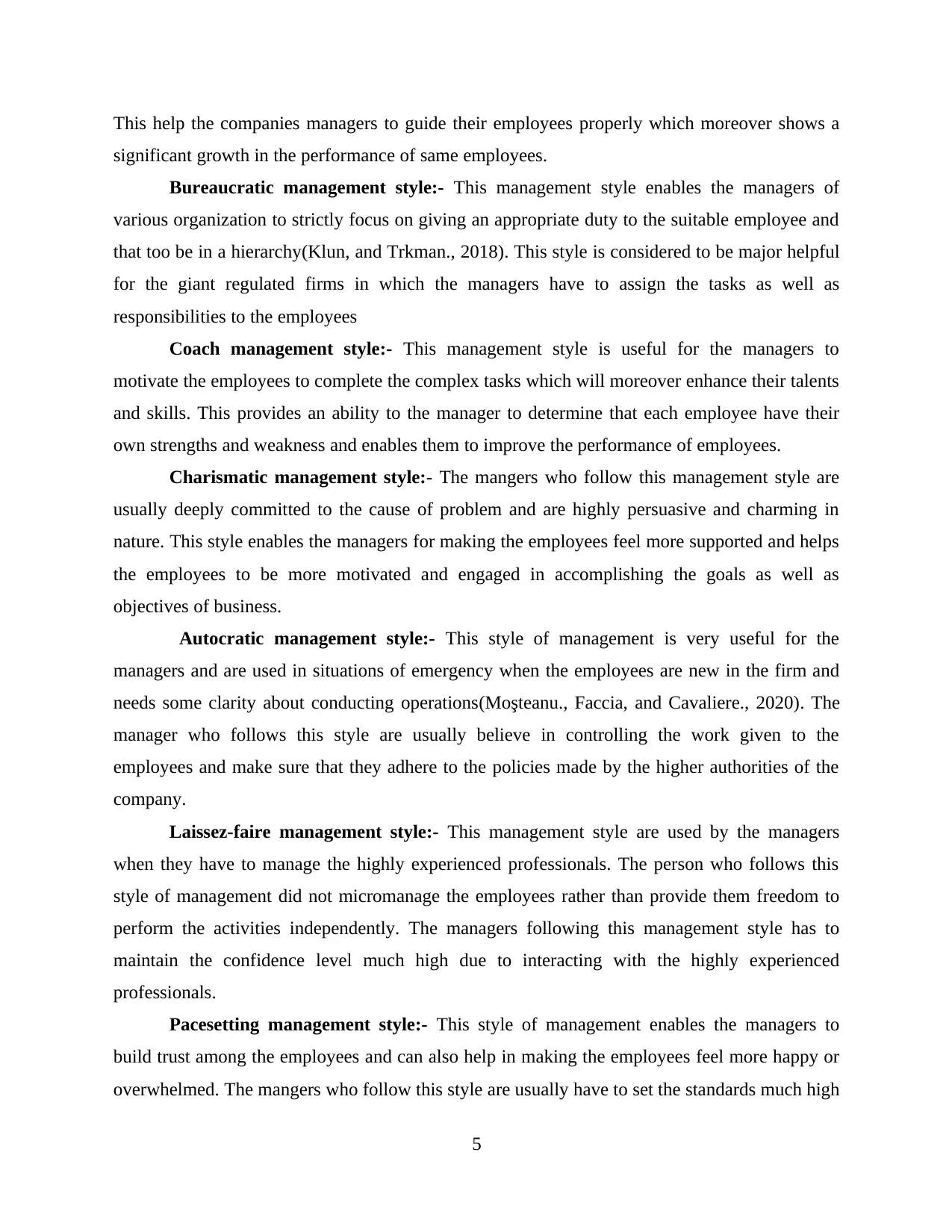
This help the companies managers to guide their employees properly which moreover shows a
significant growth in the performance of same employees.
Bureaucratic management style:- This management style enables the managers of
various organization to strictly focus on giving an appropriate duty to the suitable employee and
that too be in a hierarchy(Klun, and Trkman., 2018). This style is considered to be major helpful
for the giant regulated firms in which the managers have to assign the tasks as well as
responsibilities to the employees
Coach management style:- This management style is useful for the managers to
motivate the employees to complete the complex tasks which will moreover enhance their talents
and skills. This provides an ability to the manager to determine that each employee have their
own strengths and weakness and enables them to improve the performance of employees.
Charismatic management style:- The mangers who follow this management style are
usually deeply committed to the cause of problem and are highly persuasive and charming in
nature. This style enables the managers for making the employees feel more supported and helps
the employees to be more motivated and engaged in accomplishing the goals as well as
objectives of business.
Autocratic management style:- This style of management is very useful for the
managers and are used in situations of emergency when the employees are new in the firm and
needs some clarity about conducting operations(Moşteanu., Faccia, and Cavaliere., 2020). The
manager who follows this style are usually believe in controlling the work given to the
employees and make sure that they adhere to the policies made by the higher authorities of the
company.
Laissez-faire management style:- This management style are used by the managers
when they have to manage the highly experienced professionals. The person who follows this
style of management did not micromanage the employees rather than provide them freedom to
perform the activities independently. The managers following this management style has to
maintain the confidence level much high due to interacting with the highly experienced
professionals.
Pacesetting management style:- This style of management enables the managers to
build trust among the employees and can also help in making the employees feel more happy or
overwhelmed. The mangers who follow this style are usually have to set the standards much high
5
significant growth in the performance of same employees.
Bureaucratic management style:- This management style enables the managers of
various organization to strictly focus on giving an appropriate duty to the suitable employee and
that too be in a hierarchy(Klun, and Trkman., 2018). This style is considered to be major helpful
for the giant regulated firms in which the managers have to assign the tasks as well as
responsibilities to the employees
Coach management style:- This management style is useful for the managers to
motivate the employees to complete the complex tasks which will moreover enhance their talents
and skills. This provides an ability to the manager to determine that each employee have their
own strengths and weakness and enables them to improve the performance of employees.
Charismatic management style:- The mangers who follow this management style are
usually deeply committed to the cause of problem and are highly persuasive and charming in
nature. This style enables the managers for making the employees feel more supported and helps
the employees to be more motivated and engaged in accomplishing the goals as well as
objectives of business.
Autocratic management style:- This style of management is very useful for the
managers and are used in situations of emergency when the employees are new in the firm and
needs some clarity about conducting operations(Moşteanu., Faccia, and Cavaliere., 2020). The
manager who follows this style are usually believe in controlling the work given to the
employees and make sure that they adhere to the policies made by the higher authorities of the
company.
Laissez-faire management style:- This management style are used by the managers
when they have to manage the highly experienced professionals. The person who follows this
style of management did not micromanage the employees rather than provide them freedom to
perform the activities independently. The managers following this management style has to
maintain the confidence level much high due to interacting with the highly experienced
professionals.
Pacesetting management style:- This style of management enables the managers to
build trust among the employees and can also help in making the employees feel more happy or
overwhelmed. The mangers who follow this style are usually have to set the standards much high
5
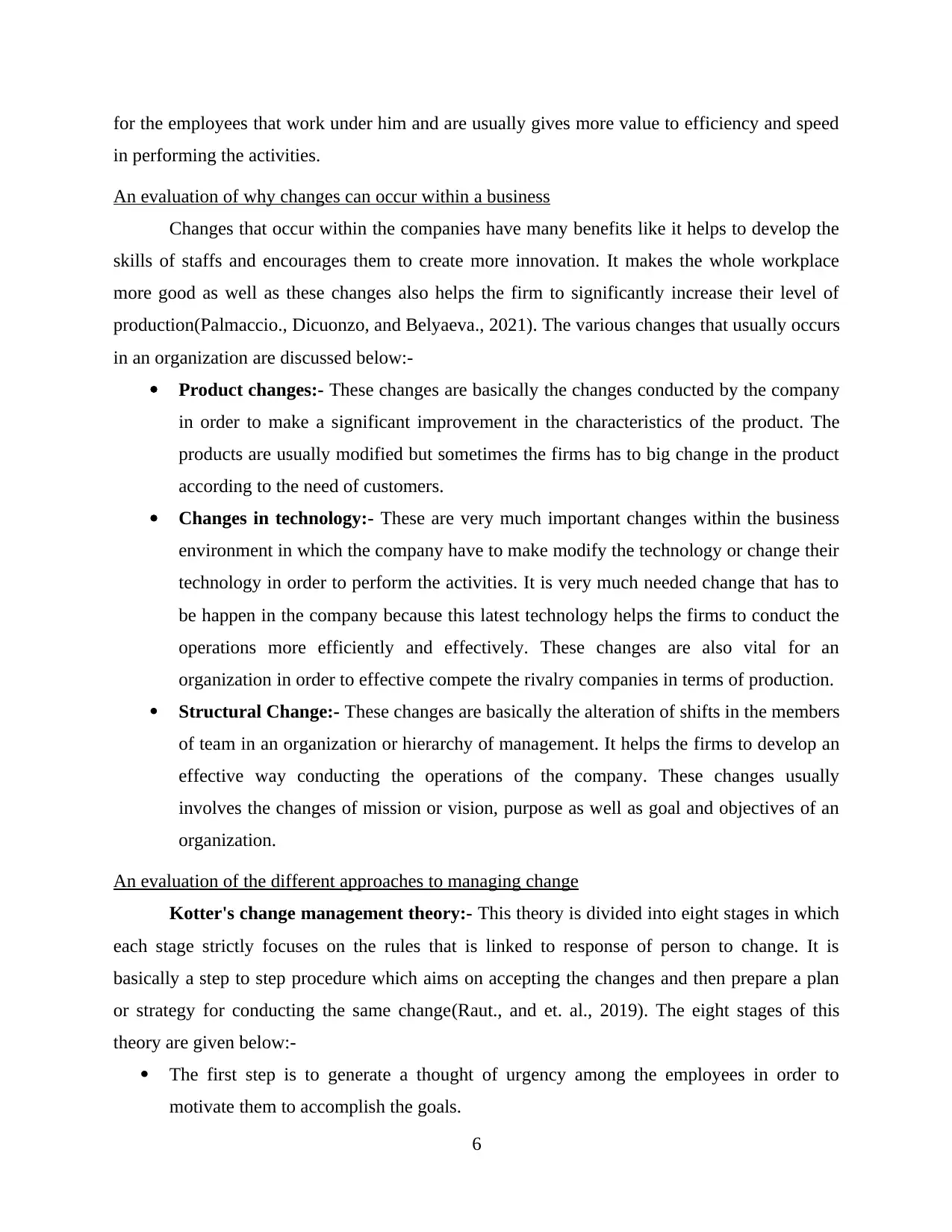
for the employees that work under him and are usually gives more value to efficiency and speed
in performing the activities.
An evaluation of why changes can occur within a business
Changes that occur within the companies have many benefits like it helps to develop the
skills of staffs and encourages them to create more innovation. It makes the whole workplace
more good as well as these changes also helps the firm to significantly increase their level of
production(Palmaccio., Dicuonzo, and Belyaeva., 2021). The various changes that usually occurs
in an organization are discussed below:-
Product changes:- These changes are basically the changes conducted by the company
in order to make a significant improvement in the characteristics of the product. The
products are usually modified but sometimes the firms has to big change in the product
according to the need of customers.
Changes in technology:- These are very much important changes within the business
environment in which the company have to make modify the technology or change their
technology in order to perform the activities. It is very much needed change that has to
be happen in the company because this latest technology helps the firms to conduct the
operations more efficiently and effectively. These changes are also vital for an
organization in order to effective compete the rivalry companies in terms of production.
Structural Change:- These changes are basically the alteration of shifts in the members
of team in an organization or hierarchy of management. It helps the firms to develop an
effective way conducting the operations of the company. These changes usually
involves the changes of mission or vision, purpose as well as goal and objectives of an
organization.
An evaluation of the different approaches to managing change
Kotter's change management theory:- This theory is divided into eight stages in which
each stage strictly focuses on the rules that is linked to response of person to change. It is
basically a step to step procedure which aims on accepting the changes and then prepare a plan
or strategy for conducting the same change(Raut., and et. al., 2019). The eight stages of this
theory are given below:-
The first step is to generate a thought of urgency among the employees in order to
motivate them to accomplish the goals.
6
in performing the activities.
An evaluation of why changes can occur within a business
Changes that occur within the companies have many benefits like it helps to develop the
skills of staffs and encourages them to create more innovation. It makes the whole workplace
more good as well as these changes also helps the firm to significantly increase their level of
production(Palmaccio., Dicuonzo, and Belyaeva., 2021). The various changes that usually occurs
in an organization are discussed below:-
Product changes:- These changes are basically the changes conducted by the company
in order to make a significant improvement in the characteristics of the product. The
products are usually modified but sometimes the firms has to big change in the product
according to the need of customers.
Changes in technology:- These are very much important changes within the business
environment in which the company have to make modify the technology or change their
technology in order to perform the activities. It is very much needed change that has to
be happen in the company because this latest technology helps the firms to conduct the
operations more efficiently and effectively. These changes are also vital for an
organization in order to effective compete the rivalry companies in terms of production.
Structural Change:- These changes are basically the alteration of shifts in the members
of team in an organization or hierarchy of management. It helps the firms to develop an
effective way conducting the operations of the company. These changes usually
involves the changes of mission or vision, purpose as well as goal and objectives of an
organization.
An evaluation of the different approaches to managing change
Kotter's change management theory:- This theory is divided into eight stages in which
each stage strictly focuses on the rules that is linked to response of person to change. It is
basically a step to step procedure which aims on accepting the changes and then prepare a plan
or strategy for conducting the same change(Raut., and et. al., 2019). The eight stages of this
theory are given below:-
The first step is to generate a thought of urgency among the employees in order to
motivate them to accomplish the goals.
6
⊘ This is a preview!⊘
Do you want full access?
Subscribe today to unlock all pages.

Trusted by 1+ million students worldwide
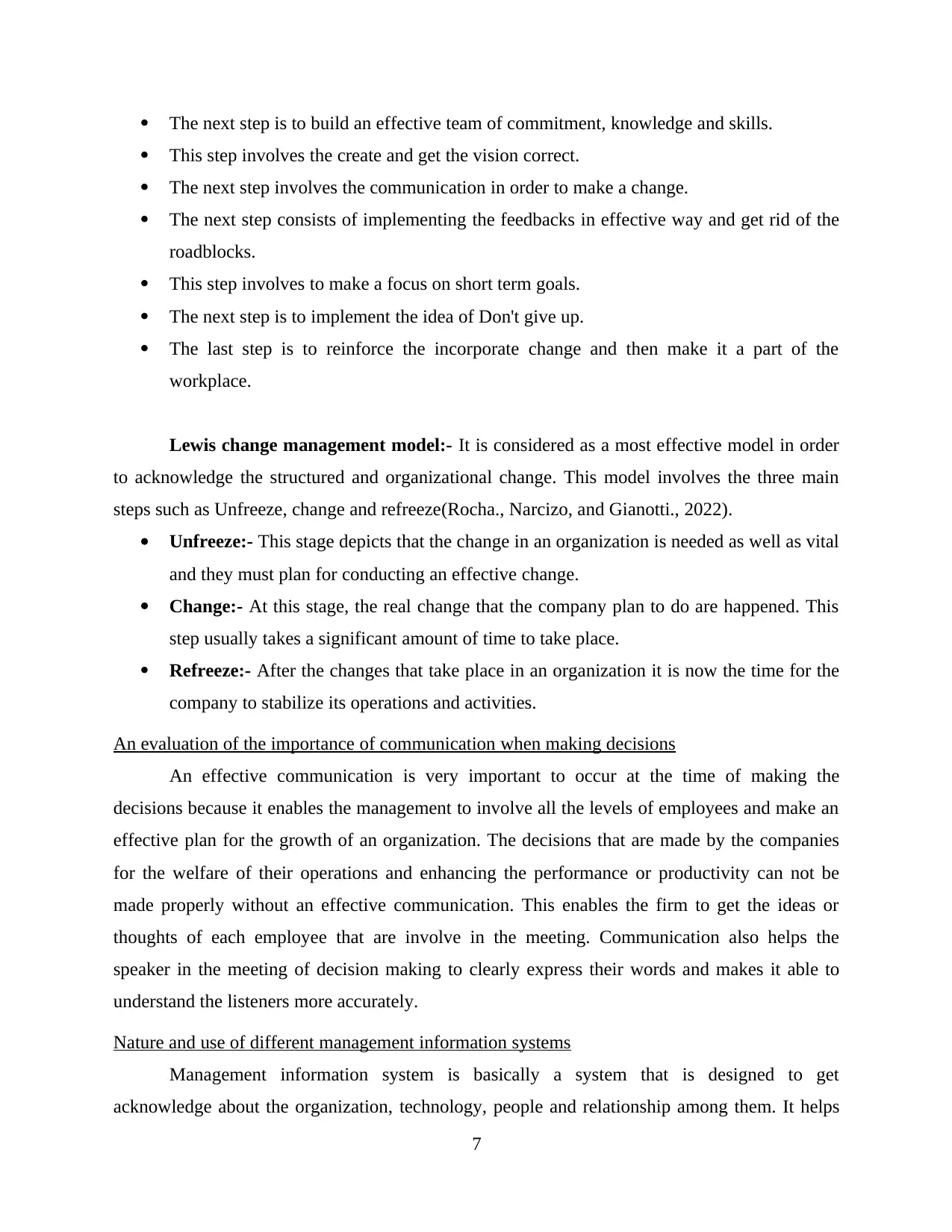
The next step is to build an effective team of commitment, knowledge and skills.
This step involves the create and get the vision correct.
The next step involves the communication in order to make a change.
The next step consists of implementing the feedbacks in effective way and get rid of the
roadblocks.
This step involves to make a focus on short term goals.
The next step is to implement the idea of Don't give up.
The last step is to reinforce the incorporate change and then make it a part of the
workplace.
Lewis change management model:- It is considered as a most effective model in order
to acknowledge the structured and organizational change. This model involves the three main
steps such as Unfreeze, change and refreeze(Rocha., Narcizo, and Gianotti., 2022).
Unfreeze:- This stage depicts that the change in an organization is needed as well as vital
and they must plan for conducting an effective change.
Change:- At this stage, the real change that the company plan to do are happened. This
step usually takes a significant amount of time to take place.
Refreeze:- After the changes that take place in an organization it is now the time for the
company to stabilize its operations and activities.
An evaluation of the importance of communication when making decisions
An effective communication is very important to occur at the time of making the
decisions because it enables the management to involve all the levels of employees and make an
effective plan for the growth of an organization. The decisions that are made by the companies
for the welfare of their operations and enhancing the performance or productivity can not be
made properly without an effective communication. This enables the firm to get the ideas or
thoughts of each employee that are involve in the meeting. Communication also helps the
speaker in the meeting of decision making to clearly express their words and makes it able to
understand the listeners more accurately.
Nature and use of different management information systems
Management information system is basically a system that is designed to get
acknowledge about the organization, technology, people and relationship among them. It helps
7
This step involves the create and get the vision correct.
The next step involves the communication in order to make a change.
The next step consists of implementing the feedbacks in effective way and get rid of the
roadblocks.
This step involves to make a focus on short term goals.
The next step is to implement the idea of Don't give up.
The last step is to reinforce the incorporate change and then make it a part of the
workplace.
Lewis change management model:- It is considered as a most effective model in order
to acknowledge the structured and organizational change. This model involves the three main
steps such as Unfreeze, change and refreeze(Rocha., Narcizo, and Gianotti., 2022).
Unfreeze:- This stage depicts that the change in an organization is needed as well as vital
and they must plan for conducting an effective change.
Change:- At this stage, the real change that the company plan to do are happened. This
step usually takes a significant amount of time to take place.
Refreeze:- After the changes that take place in an organization it is now the time for the
company to stabilize its operations and activities.
An evaluation of the importance of communication when making decisions
An effective communication is very important to occur at the time of making the
decisions because it enables the management to involve all the levels of employees and make an
effective plan for the growth of an organization. The decisions that are made by the companies
for the welfare of their operations and enhancing the performance or productivity can not be
made properly without an effective communication. This enables the firm to get the ideas or
thoughts of each employee that are involve in the meeting. Communication also helps the
speaker in the meeting of decision making to clearly express their words and makes it able to
understand the listeners more accurately.
Nature and use of different management information systems
Management information system is basically a system that is designed to get
acknowledge about the organization, technology, people and relationship among them. It helps
7
Paraphrase This Document
Need a fresh take? Get an instant paraphrase of this document with our AI Paraphraser
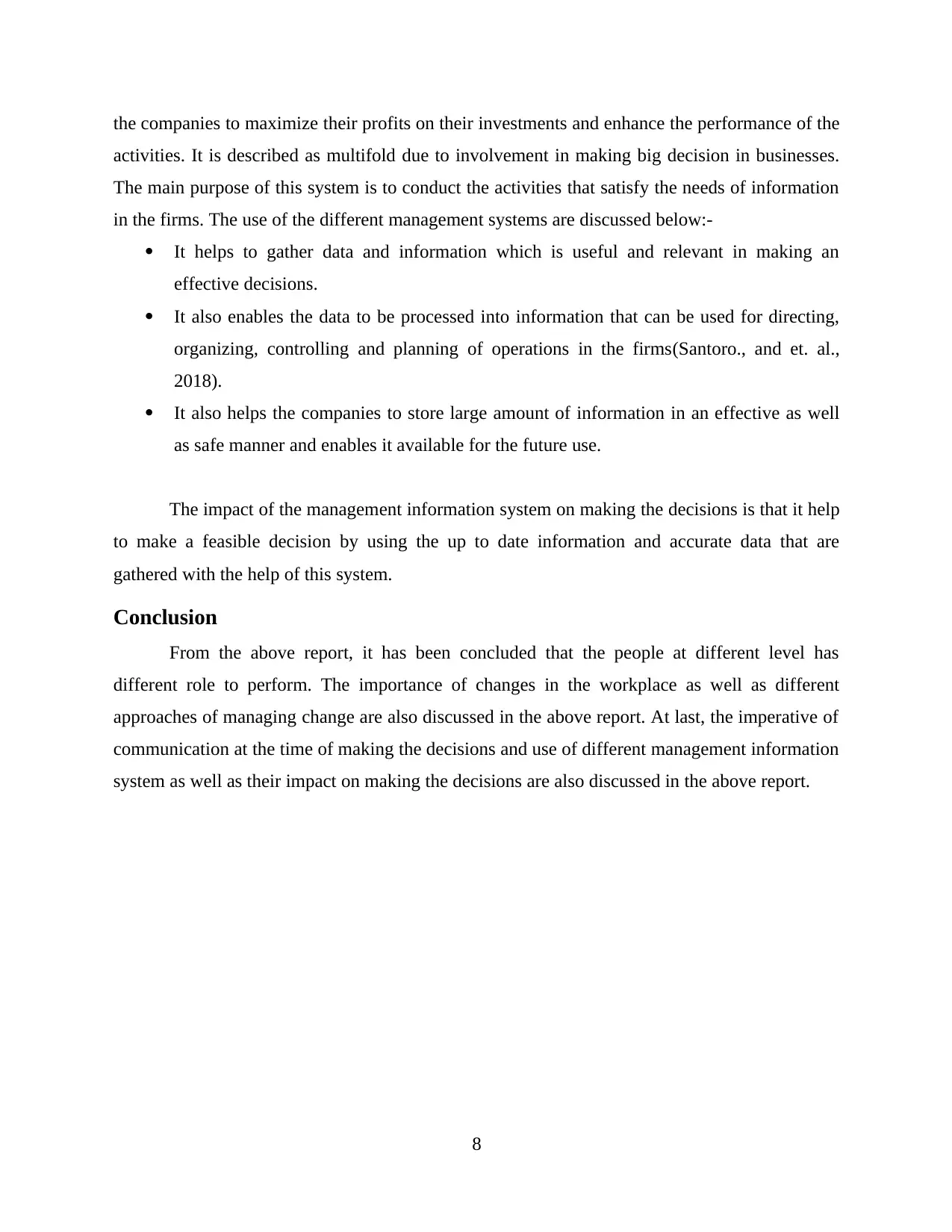
the companies to maximize their profits on their investments and enhance the performance of the
activities. It is described as multifold due to involvement in making big decision in businesses.
The main purpose of this system is to conduct the activities that satisfy the needs of information
in the firms. The use of the different management systems are discussed below:-
It helps to gather data and information which is useful and relevant in making an
effective decisions.
It also enables the data to be processed into information that can be used for directing,
organizing, controlling and planning of operations in the firms(Santoro., and et. al.,
2018).
It also helps the companies to store large amount of information in an effective as well
as safe manner and enables it available for the future use.
The impact of the management information system on making the decisions is that it help
to make a feasible decision by using the up to date information and accurate data that are
gathered with the help of this system.
Conclusion
From the above report, it has been concluded that the people at different level has
different role to perform. The importance of changes in the workplace as well as different
approaches of managing change are also discussed in the above report. At last, the imperative of
communication at the time of making the decisions and use of different management information
system as well as their impact on making the decisions are also discussed in the above report.
8
activities. It is described as multifold due to involvement in making big decision in businesses.
The main purpose of this system is to conduct the activities that satisfy the needs of information
in the firms. The use of the different management systems are discussed below:-
It helps to gather data and information which is useful and relevant in making an
effective decisions.
It also enables the data to be processed into information that can be used for directing,
organizing, controlling and planning of operations in the firms(Santoro., and et. al.,
2018).
It also helps the companies to store large amount of information in an effective as well
as safe manner and enables it available for the future use.
The impact of the management information system on making the decisions is that it help
to make a feasible decision by using the up to date information and accurate data that are
gathered with the help of this system.
Conclusion
From the above report, it has been concluded that the people at different level has
different role to perform. The importance of changes in the workplace as well as different
approaches of managing change are also discussed in the above report. At last, the imperative of
communication at the time of making the decisions and use of different management information
system as well as their impact on making the decisions are also discussed in the above report.
8
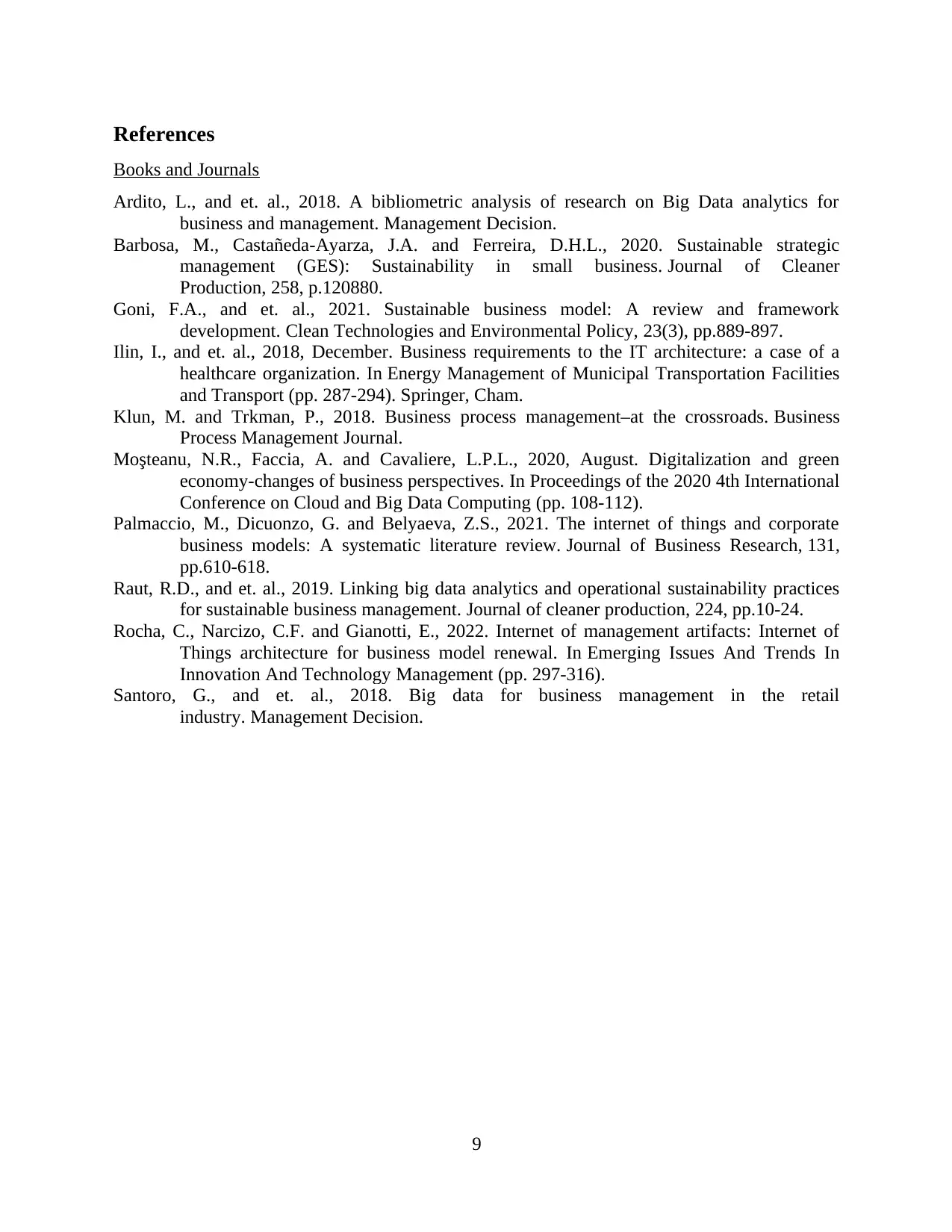
References
Books and Journals
Ardito, L., and et. al., 2018. A bibliometric analysis of research on Big Data analytics for
business and management. Management Decision.
Barbosa, M., Castañeda-Ayarza, J.A. and Ferreira, D.H.L., 2020. Sustainable strategic
management (GES): Sustainability in small business. Journal of Cleaner
Production, 258, p.120880.
Goni, F.A., and et. al., 2021. Sustainable business model: A review and framework
development. Clean Technologies and Environmental Policy, 23(3), pp.889-897.
Ilin, I., and et. al., 2018, December. Business requirements to the IT architecture: a case of a
healthcare organization. In Energy Management of Municipal Transportation Facilities
and Transport (pp. 287-294). Springer, Cham.
Klun, M. and Trkman, P., 2018. Business process management–at the crossroads. Business
Process Management Journal.
Moşteanu, N.R., Faccia, A. and Cavaliere, L.P.L., 2020, August. Digitalization and green
economy-changes of business perspectives. In Proceedings of the 2020 4th International
Conference on Cloud and Big Data Computing (pp. 108-112).
Palmaccio, M., Dicuonzo, G. and Belyaeva, Z.S., 2021. The internet of things and corporate
business models: A systematic literature review. Journal of Business Research, 131,
pp.610-618.
Raut, R.D., and et. al., 2019. Linking big data analytics and operational sustainability practices
for sustainable business management. Journal of cleaner production, 224, pp.10-24.
Rocha, C., Narcizo, C.F. and Gianotti, E., 2022. Internet of management artifacts: Internet of
Things architecture for business model renewal. In Emerging Issues And Trends In
Innovation And Technology Management (pp. 297-316).
Santoro, G., and et. al., 2018. Big data for business management in the retail
industry. Management Decision.
9
Books and Journals
Ardito, L., and et. al., 2018. A bibliometric analysis of research on Big Data analytics for
business and management. Management Decision.
Barbosa, M., Castañeda-Ayarza, J.A. and Ferreira, D.H.L., 2020. Sustainable strategic
management (GES): Sustainability in small business. Journal of Cleaner
Production, 258, p.120880.
Goni, F.A., and et. al., 2021. Sustainable business model: A review and framework
development. Clean Technologies and Environmental Policy, 23(3), pp.889-897.
Ilin, I., and et. al., 2018, December. Business requirements to the IT architecture: a case of a
healthcare organization. In Energy Management of Municipal Transportation Facilities
and Transport (pp. 287-294). Springer, Cham.
Klun, M. and Trkman, P., 2018. Business process management–at the crossroads. Business
Process Management Journal.
Moşteanu, N.R., Faccia, A. and Cavaliere, L.P.L., 2020, August. Digitalization and green
economy-changes of business perspectives. In Proceedings of the 2020 4th International
Conference on Cloud and Big Data Computing (pp. 108-112).
Palmaccio, M., Dicuonzo, G. and Belyaeva, Z.S., 2021. The internet of things and corporate
business models: A systematic literature review. Journal of Business Research, 131,
pp.610-618.
Raut, R.D., and et. al., 2019. Linking big data analytics and operational sustainability practices
for sustainable business management. Journal of cleaner production, 224, pp.10-24.
Rocha, C., Narcizo, C.F. and Gianotti, E., 2022. Internet of management artifacts: Internet of
Things architecture for business model renewal. In Emerging Issues And Trends In
Innovation And Technology Management (pp. 297-316).
Santoro, G., and et. al., 2018. Big data for business management in the retail
industry. Management Decision.
9
⊘ This is a preview!⊘
Do you want full access?
Subscribe today to unlock all pages.

Trusted by 1+ million students worldwide
1 out of 9
Related Documents
Your All-in-One AI-Powered Toolkit for Academic Success.
+13062052269
info@desklib.com
Available 24*7 on WhatsApp / Email
![[object Object]](/_next/static/media/star-bottom.7253800d.svg)
Unlock your academic potential
Copyright © 2020–2025 A2Z Services. All Rights Reserved. Developed and managed by ZUCOL.





